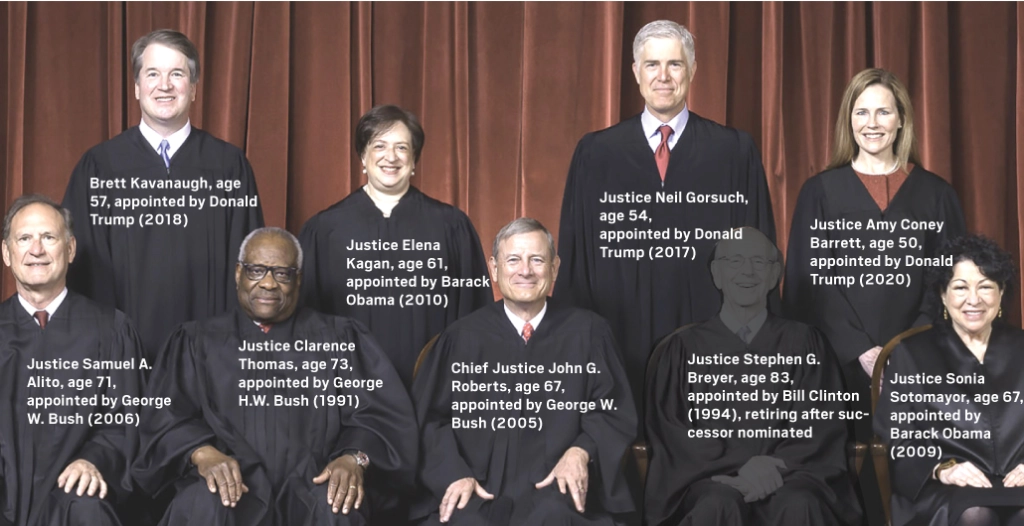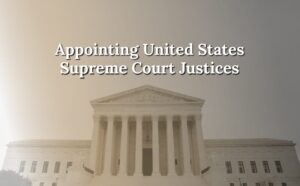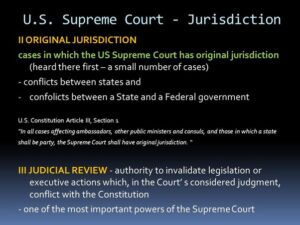Who Appoints Supreme Court Justices?
The Supreme Court of the United States, established by the Constitution, is the highest judicial body in the nation. It plays a crucial role in interpreting the law and ensuring its adherence to the principles laid out in the Constitution. As a result, the appointment of Supreme Court Justices is a matter of immense importance that can shape the nation’s legal landscape for decades to come.
The Supreme Court of the United States
Before delving into the appointment process, let’s briefly understand the significance of the Supreme Court. Comprising nine justices, the Supreme Court acts as the final arbiter of legal disputes and is entrusted with safeguarding the Constitution’s integrity. The decisions made by this court have far-reaching consequences, impacting the lives of millions of Americans.
how are supreme court justices chosen
The appointment of Supreme Court Justices involves a rigorous and multi-step process.
Presidential Nomination
The President of the United States holds the authority to nominate individuals for vacant positions on the Supreme Court. This nomination is a critical decision that can shape the country’s legal direction. Presidents often select candidates who align with their political ideologies, reflecting their desire to leave a lasting impact on the nation’s laws.
Senate Judiciary Committee
Once nominated, the candidates appear before the Senate Judiciary Committee. During this process, candidates are questioned extensively about their qualifications, past decisions, and judicial philosophies. The Judiciary Committee evaluates the nominees’ suitability for a position on the Supreme Court.
Senate Confirmation
Following the Judiciary Committee’s evaluation, the nomination moves to the full Senate for confirmation. The Senate holds hearings where senators further examine the nominee’s credentials and engage in debates about their suitability. A simple majority vote is required for confirmation.
Factors Considered for Nomination
Presidents and senators consider several crucial factors when nominating and confirming Supreme Court Justices.
Legal Experience and Expertise
Nominees typically have extensive legal backgrounds, often serving as judges in lower courts or holding prominent legal positions. Their expertise and understanding of the law are vital for effective Supreme Court service.
Ideology and Judicial Philosophy
The political ideology and judicial philosophy of nominees can significantly influence the decisions they make on the bench. Presidents and senators seek individuals who share their values and will contribute to their vision of justice.
Diversity and Representation
In recent years, there has been an increased emphasis on appointing justices who represent diverse backgrounds. The goal is to ensure that the Supreme Court reflects the nation’s diversity and understands the unique challenges faced by different communities.
Confirmation Process Challenges
The confirmation process for Supreme Court Justices is not without its challenges.
Partisan Politics
Supreme Court appointments have become highly politicized, with parties vying for control of the Court to sway decisions in their favor. This has led to intense battles during confirmation proceedings.
Ideological Battles
Senators often engage in ideological battles during the confirmation process, reflecting the larger political divides within the country.
Public Scrutiny
Nominees face extensive public scrutiny, with their past decisions and personal lives subject to intense examination. This level of scrutiny can sometimes become overwhelming and impact the confirmation process.
Historical Context: Evolution of the Appointment Process
The process of appointing Supreme Court justices has evolved over the years, reflecting changing societal norms and political dynamics. Initially, the process was relatively straightforward, but it has since become a complex procedure involving multiple stages and stakeholders.
Scrutiny and Hearings: Evaluating Nominees
Nominees undergo rigorous scrutiny during Senate confirmation hearings. Senators question nominees on their judicial philosophy, prior rulings, and potential biases. These hearings provide insight into how a justice might interpret the Constitution and handle future cases.
Public Opinion and Stakeholder Influence
Public opinion and interest groups exert considerable influence during the appointment process. Protests, advocacy campaigns, and media coverage can shape the narrative around a nominee and impact senators’ decisions.
The Lifetime Appointment Debate
The lifetime appointment of justices raises important questions about accountability and the potential for justices to remain out of touch with changing societal norms. This debate has led to discussions about term limits or mandatory retirement ages for justices.
Diversity on the Bench: A Modern Imperative
Efforts to diversify the Supreme Court have gained momentum in recent years. The push for justices from varied backgrounds aims to ensure a more inclusive and representative judiciary that can address a wide range of legal issues.
Landmark Cases and Lasting Legacies
Supreme Court justices are often remembered for their contributions to landmark cases that shape legal precedents. These cases have lasting impacts on civil rights, social issues, and the balance of power between government branches.
The Intersection of Politics and Judiciary
The appointment process can become highly political, as justices’ decisions can influence the nation’s course for decades. The ideological balance of the court can sway based on the timing of vacancies and appointments.
Presidential Transitions and Vacancies
Vacancies that occur during presidential transitions add an additional layer of complexity to the appointment process. The outgoing and incoming presidents may have differing priorities and ideologies, affecting the type of justice appointed.
The Changing Dynamics of Judicial Appointments
Over time, the appointment process has witnessed changes in transparency, partisan politics, and the role of interest groups. These dynamics reflect the evolving nature of American society and its legal system.
International Perspectives: Comparative Analysis
Looking beyond the United States, various countries have different approaches to appointing judges. A comparative analysis highlights the strengths and weaknesses of different systems and provides insights into potential improvements.
Ensuring an Independent Judiciary
The appointment process is designed to ensure an independent judiciary that upholds the rule of law. Balancing the influence of different branches of government while considering public opinion is essential for maintaining trust in the justice system.
Conclusion: Shaping the Course of Justice
The appointment of Supreme Court justices is a multifaceted process that merges politics, law, and public sentiment. The individuals who ascend to the bench carry a heavy responsibility, as their decisions reverberate through the nation’s history.
FAQs
- Can Supreme Court justices be removed from office? Supreme Court justices can only be removed through impeachment by the House of Representatives and conviction by the Senate.
- How does the Supreme Court choose which cases to hear? The Court typically selects cases that involve significant legal questions, have conflicting lower court decisions, or address constitutional issues.
- What is the role of the Chief Justice? The Chief Justice presides over the Court’s public sessions and plays a key administrative role in its functioning.
- How do dissenting opinions affect legal precedent? Dissenting opinions don’t set legal precedent but can influence future interpretations of the law.
- Why is the Supreme Court called the “highest court in the land”? The Supreme Court’s decisions are final, and its interpretations of the Constitution are binding throughout the United States.
- Q: How long do Supreme Court Justices serve?
- A: Supreme Court Justices serve for life or until they choose to retire.
- Q: How are Supreme Court Justices selected?
- A: The President nominates candidates, and the Senate confirms them.
- Q: Can the Senate reject a nominee?
- A: Yes, the Senate has the authority to reject a nominee through the confirmation process.
- Q: How many Justices are on the Supreme Court?
- A: There are nine Justices on the Supreme Court.
- Q: Are Supreme Court Justices politically neutral?
- A: Supreme Court Justices strive to be politically impartial, but their ideologies can influence their decisions.








